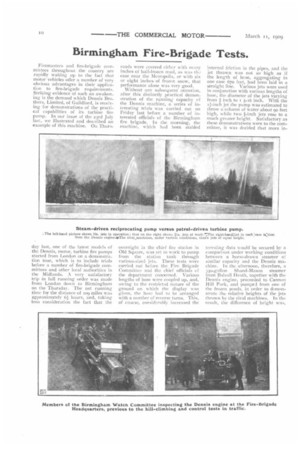Birmingham Fire-Brigade Tests.
Page 10

Page 11

If you've noticed an error in this article please click here to report it so we can fix it.
Firemasters and fire-brigade committees throughout the country are rapidly waking up to the fact that motor vehicles offer a number of very obvious advantages in their application to fire-brigade requirements. Striking evidence of such an awaken_ ing is the demand which Dennis Brothers, Limited, of Guildford, is receiving for demonstrations of the practical capabilities of its turbine tire pump. In our issue of the 23rd July last, we illustrated and described an example of this machine. On Thurs
day last, one of the latest models of the Dennis, motor, turbine fire pumps started from London on a demonstration tour, which is to include trials before a number of fire-brigade committees and other local authorities in the Midlands. A very satisfactory trip in full running order was made front London down to Birmingham on the Thursday. The net running time for the distance of io9 miles was 'approximately 6"-, hours, and, taking into consideration the fact that the roads were covered either with many inches of half-frozen mud, as was th.: case near the Metropolis, or with six or eight inches of frozen snow, that performance alone was very good.
Without any subsequent attention, after this distinctly practical demonstration of the running capacity of the Dennis machine, a series of interestingtrials was carried out on Friday last before a number of interested officials of the Birmingham fire brigade. In the morning, the machine, which had been stabled
overnight ;n the chief fire station in Old Square, was set to work to pump from the station tank through various-sized jets. These tests were carried out before the Fire Brigade Committee and the chief officials of the department concerned. Various lengths of hose were coupled up, and owing to the restricted nature of the ground on which the display was given, the hose had to be arranged with a number of reverse turns. This, of course, considerably increased the internal friction in the pipes, and the jet thrown was not so high as if the length of hese, aggregating in one case 670 feet, had been laid in a straight line. Various jets were used in conjunction with various lengths of hose, the diameter of the jets varying from 1 inch to 5-to inch. With the 11-inch jet the pump was estimated to throw a column of water about 90 feet high, while two 1-inch jets rose to a much greater height. Satisfactory as these demonstrations were to the committee, it was decided that more in
terestingdata would be secured by a comparison under working conditions between a horse-drawn steamer of similar capacity and the Dennis machine. In the afternoon, therefore, a 'to-gallon Shand-Mason steamer from Balsa11 Heath, together with the Dennis engine, proceeded to Cannon Hill Park, and pumped from one of the frozen fronds; in order to demonstrate the relative heights of the jets thrown by the rival machines, In the result, the difference of height was,
for all sizes of jet, scarcely noticeable, although, to an onlooker, the jet seemed cleaner and more regular in the case of the turbine pump. A point of superiority on which the Dennis distinctly scored was the fact that, over roads which were in execrable condition, the motor vehicle experienced no difficulty in travelling at a high rate of speed, whereas the horsedrawo machine was severely handicapped in this respect. The ease and rapidity with which the Dennis was started up and got to work contrasted very favourably with the comparatively cumbersome methods that had to be employed on the steamer. The cleanliness of. operation of the motor vehicle was also a very favourable contrast to the dirt and mess caused by the stoking and firing of the steamdriven machine.
Previous 'to the tests in Cannon Hill Park, Superintendent Tozer, the new energetic chief of the Birmingham Brigade, had the Dennis driven through some of the narrowest streets in Birmingham ; the surfaces over which the vehicle proceeded were in a very treacherous condition. As a crucial test, Superintendent Tozer had the vehicle driven up the Bull Ring,
which has one of the worst gradients in Birmingham, and one which all .fire-brigade appliances in that city have frequently to surmount. The gradient at one point approximates in 8. The vehicle went up at a speed which was estimated at well over eight miles an hour. Dennis Brothers, Limited, is to be congratulated on the excellent showing of its machine in comparison ‘vith the horsedrawn steam vehicle, which latter, there is little doubt, automobile fire appliances are destined almost entirely to supplant throughout the country in the near future.






















